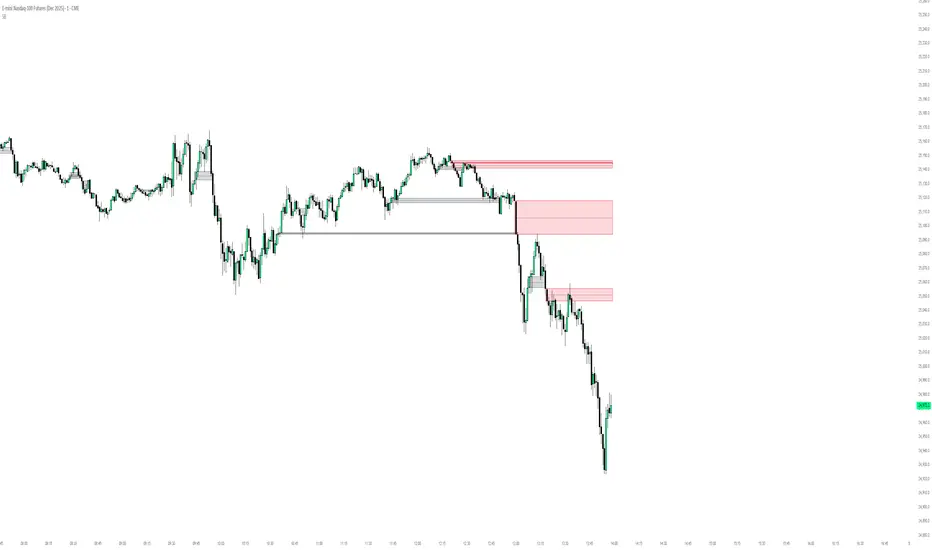OPEN-SOURCE SCRIPT
ICT Suspension Blocks

ICT Suspension Block (SB) Indicator
The ICT Suspension Block (SB) is a three-candle price action pattern that often act as support or resistance zones. A Suspension Block is a three-candle pattern showing a brief pause in price efficiency before continuation. These zones frequently serve as areas where price may later return, offering traders potential trading opportunities.
Pattern Definition
A Suspension Block forms when three consecutive candles move in the same direction but leave behind a specific body-to-body imbalance. (a gap between the bodies of consecutive candles).
Bullish Suspension Block (+SB):
Bearish Suspension Block (-SB):
These zones mark areas where price was temporarily imbalanced. Price often “respects” these levels later, either bouncing from them or breaking through them, which can provide valuable trade context.
Application
The significance of a block depends on market context. Blocks formed during strong, impulsive moves tend to be more meaningful than those in consolidation.
How the Indicator Works
Features
How to Use It
Notes
The ICT Suspension Block (SB) is a three-candle price action pattern that often act as support or resistance zones. A Suspension Block is a three-candle pattern showing a brief pause in price efficiency before continuation. These zones frequently serve as areas where price may later return, offering traders potential trading opportunities.
Pattern Definition
A Suspension Block forms when three consecutive candles move in the same direction but leave behind a specific body-to-body imbalance. (a gap between the bodies of consecutive candles).
Bullish Suspension Block (+SB):
- All three candles are bullish (close > open).
- Candle 1 close < Candle 2 open.
- Candle 2 close < Candle 3 open.
- Zone = from Candle 1 close to Candle 3 open.
Bearish Suspension Block (-SB):
- All three candles are bearish (close < open).
- Candle 1 close > Candle 2 open.
- Candle 2 close > Candle 3 open.
- Zone = from Candle 1 close to Candle 3 open.
These zones mark areas where price was temporarily imbalanced. Price often “respects” these levels later, either bouncing from them or breaking through them, which can provide valuable trade context.
Application
- Suspension Blocks are used to mark areas where price may later react:
- A Bullish SB can act as potential support.
- A Bearish SB can act as potential resistance.
The significance of a block depends on market context. Blocks formed during strong, impulsive moves tend to be more meaningful than those in consolidation.
How the Indicator Works
- Identifies bullish and bearish suspension blocks using body gap imbalances.
- Draws colored zones (green = bullish, red = bearish) directly on the chart.
- Extends zones forward until they are inversed by price action.
- Once inversed, zones switch to a neutral color, allowing traders to annotate/extend them manually if desired.
- Includes Consequent Encroachment (CE) lines (the 50% equilibrium of the block), which many traders use as reaction levels.
Features
- Customizable colors for bullish, bearish, and inversed zones
- Extend blocks indefinitely forward or limit them to a set number of bars
- Adjustable maximum number of displayed blocks for performance control
- Consequent Encroachment (CE) (Middle Point, 50%, Equilibrium) line feature
- Configurable CE line style, color, and width
How to Use It
- Trend Following: Blocks forming in the direction of trend can act as continuation zones.
- Reversals: Opposite-direction blocks may signal exhaustion and potential turning points.
- Liquidity Levels: CE lines (50% of block) often serve as reaction levels for entries, partials, or stop placement.
- Context is Key: Suspension Blocks should not be used in isolation. Combine them with market structure, liquidity pools, or other confluence factors for best results.
Notes
- This indicator is intended for technical analysis and research.
- It should always be combined with proper risk management and a complete trading plan.
- Past market behavior does not guarantee future results.
Open-source script
In true TradingView spirit, the creator of this script has made it open-source, so that traders can review and verify its functionality. Kudos to the author! While you can use it for free, remember that republishing the code is subject to our House Rules.
Disclaimer
The information and publications are not meant to be, and do not constitute, financial, investment, trading, or other types of advice or recommendations supplied or endorsed by TradingView. Read more in the Terms of Use.
Open-source script
In true TradingView spirit, the creator of this script has made it open-source, so that traders can review and verify its functionality. Kudos to the author! While you can use it for free, remember that republishing the code is subject to our House Rules.
Disclaimer
The information and publications are not meant to be, and do not constitute, financial, investment, trading, or other types of advice or recommendations supplied or endorsed by TradingView. Read more in the Terms of Use.